 |
One of the critical issues of our time is the conservation of energy. Fritz Reiner was way ahead of the curve. To understand his art is to appreciate the true meaning of economy.
 Most of us tend to think of conductors as wild men, flailing away to wrest impassioned music out of a staid orchestra. Leonard Bernstein, Reiner's most famous student, perhaps did more than anyone to cement this image in the public mind. And yet, perhaps the most startling image of Bernstein is found in a 1971 film in which he conducts the finale of Beethoven's “Choral” Symphony in Vienna. Right up to the end of the fugue of the development section, he puts on the usual kinetic “Lenny dance,” full of huge, exaggerated gestures, leaps and grimaces to underline each detail of his complex vision. True to form, he painstakingly calms the players during the hushed transition. Then, as the great theme bursts through for the recapitulation, we fully expect Bernstein to explode with acrobatic ecstasy. But instead, he firmly conducts the first few beats and then just stands nearly still for a full half-minute, letting the mighty tide of glorious sound wash over him, giving only an occasional involuntary shrug of his shoulders at the downbeats. Most of us tend to think of conductors as wild men, flailing away to wrest impassioned music out of a staid orchestra. Leonard Bernstein, Reiner's most famous student, perhaps did more than anyone to cement this image in the public mind. And yet, perhaps the most startling image of Bernstein is found in a 1971 film in which he conducts the finale of Beethoven's “Choral” Symphony in Vienna. Right up to the end of the fugue of the development section, he puts on the usual kinetic “Lenny dance,” full of huge, exaggerated gestures, leaps and grimaces to underline each detail of his complex vision. True to form, he painstakingly calms the players during the hushed transition. Then, as the great theme bursts through for the recapitulation, we fully expect Bernstein to explode with acrobatic ecstasy. But instead, he firmly conducts the first few beats and then just stands nearly still for a full half-minute, letting the mighty tide of glorious sound wash over him, giving only an occasional involuntary shrug of his shoulders at the downbeats.
Bernstein was a great artist. Never hesitant to pour his enormous reserves of energy into achieving a musical result, he also understood when such displays were unneeded. Having carefully prepared the restatement of Beethoven's wonderful but simple melody which the artists had performed hundreds of times, there was nothing more for him to contribute. Despite his penchant for visual theatrics, Bernstein understood the virtue of economy. Fritz Reiner worshipped it.
Although he was one of Bernstein's teachers and major influences, Reiner was at the extreme opposite end of the emotional spectrum. His approach can be seen in a Teldec video, The Art of Conducting. Throughout the opening of Beethoven's Symphony # 7, his baton appears nearly stationary, forcing the musicians to concentrate. When his hyper-critical ears detect a problem, he slowly turns his head to the offending player and simply glowers. When other conductors such as Richard Strauss did such things, they were accused of inattention and laziness. Reiner's economy, though, was wholly physical; hidden from view was an exhausting mental process during which he thoroughly absorbed and internalized a score and then channeled his powers so intensely that he had no need for overt display (nor, perhaps, any energy left to produce one).
Reiner was a strict disciplinarian and achieved his results despite (or perhaps because of) a reputation as sarcastic, nasty and even sadistic.  His preparation was fanatic. As Irving Kolodin put it in a 1964 memorial tribute, “For Reiner, knowing was an indispensable precondition to doing.” Bernstein used to tell of how Reiner would demand that his students be able to identify the exact note a single instrument was to play at a given moment in a complex score; only then did they deserve to conduct it. Reiner held his orchestras to the same punishing standards. His preparation was fanatic. As Irving Kolodin put it in a 1964 memorial tribute, “For Reiner, knowing was an indispensable precondition to doing.” Bernstein used to tell of how Reiner would demand that his students be able to identify the exact note a single instrument was to play at a given moment in a complex score; only then did they deserve to conduct it. Reiner held his orchestras to the same punishing standards.
Born in Hungary in 1888, Reiner had prepared for a career in law. Perhaps it was this training that made him the greatest technician among conductors, applying a focused concentration and analytical logic that tuned out all outside influences. After coming to America, Reiner spent a decade in each of Cincinnati, Pittsburgh and Chicago. Known as an orchestra builder, his final and greatest edifice was the Chicago Symphony, which he led from 1953 to 1962. His tenure in Chicago neatly coincided with RCA's Living Stereo series of records. Of his dozens of tapings, most have now been reissued on CD under the Living Stereo rubric. They fully display the brilliance of Reiner's unaffected art and the precision of the last orchestra he had molded in his image.
Reiner's podium austerity fully mirrored his musical demeanor. More than any other conductor of his time, Reiner was transparent. In pictures he is always without expression. He is the one conductor about whom no one seems to have a single anecdote. He had no desire to project any personality or to impose any philosophy. A typical Reiner performance is stamped with clarity, balance, rhythmic precision, meticulous control and supreme musicianship. In lieu of personal rhetoric, Reiner let the music speak for itself.
In keeping with Reiner's artistic outlook, the magnificence of his records lies less in interpretive insight than in the sheer excellence of the orchestral playing he demanded. While volume and intensity are naturally impressive, perhaps the truer test of a great ensemble lies in the delicate nuance of quieter moments, when awkward balances and a single wayward imprecision can't be disguised. All of this is captured brilliantly in the Living Stereo recordings. Although some were made as early as 1954, all are vivid. The CD transfers, using restored original tape decks and tubed electronics, are honest and spectacularly detailed.
So if you want to feel politically correct, just listen to one of Reiner's superb performances. Marvel at how this conductor was able to achieve so much with so little outward energy - throttling a full symphonic orchestra down to the subtlest whisper or inspiring it to unleash the most shattering climax, and all with transcendental precision.
Fritz Reiner was truly ahead of his time. In these days of budget crunches and service cuts, perhaps he should be remembered not only as a great musician, but as a national hero.
On to the music - here are Reiner's Living Stereo performances released on CD so far, listed (after the first entry) in the approximate order of composition of the lead work.
- “The Reiner Sound” - Ravel: Rhapsodie Espagnole (11/56), Pavane for a Dead Princess (3/57); Liszt: Totentanz, with Byron Janis (2/59); Weber: Invitation to the Dance (4/57); Rachmaninoff: Isle of the Dead (4/57). RCA 61250.
- This volume is not only a superb introduction to Reiner's work but provides a fine opportunity to observe his genius and the virtuosity of his orchestra.
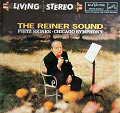 In each piece, his contribution is transparent - by shaping a performance of clarity, balance, rhythmic precision, meticulous control and supreme musicianship, but with a minimum of personal rhetoric, Reiner lets the music speak eloquently for itself. In each piece, his contribution is transparent - by shaping a performance of clarity, balance, rhythmic precision, meticulous control and supreme musicianship, but with a minimum of personal rhetoric, Reiner lets the music speak eloquently for itself.
- Ravel: Rhapsodie Espagnole - The opening is of hushed expectancy, a hazardous professional challenge in which each instrument emerges alone and exposed. Not only does this piece serve to prove the uniform excellence of each Chicago Symphony player, but Reiner preserves the musical integrity by refusing to turn the piece into a series of star turns. Rather, his selfless approach lets us revel in the full glory of Ravel's masterful orchestration, refulgent with ever-shifting aural colors.
- Ravel: Pavane for a Dead Princess - The simplicity of this piece is deceptive, melding a wistful dirge with a subtle undercurrent of constant movement. Often dismissed as a pleasant trifle, the Pavane rises to the heights of musical poetry by contrasting an ineffably sad stylized surface with irrepressible glimmers of vitality, an exquisitely soft reflection on ritual as a means to smooth and socialize the shock of personal loss. Here, Reiner is more inflected than usual, magnificently reflecting the richness of Ravel's complex consideration of the necessity for life even during the observance of death. It's a stunning, if brief, musical moment, filled with far greater depth than many ostensibly more complex artists accord it.
- Liszt: Totentanz - Like Reiner, Byron Janis was a complete virtuoso who knew how to produce an enormous impact not by storming the heavens but through control and color. In other hands, this melodramatic piece skirts the border of superficial glitz, but here, the artists treat it with integrity.
- Weber: Invitation to the Dance - Here, too, Reiner takes a fundamentally shallow piece and simply lets it speak for itself, without trying to force it into being the masterpiece it isn't. Devoid of rhetoric, its inherent grace emerges gently and utterly naturally, enabling us to share its achingly gentle vision of a young lady's dance, its formal grace and occasional splendor seen through innocent youthful eyes.
- Rachmaninoff: Isle of the Dead - This final tour de force defers to the listener's personal taste: if you regard this piece as vapid meandering, Reiner won't try to convince you otherwise; but if you're willing to be transported by a profound vision then Reiner bears you firmly aloft. Reiner simply presents the work for whatever it is toward a truly hair-raising climax, his methodic precision a more subtle but nonetheless effective form of advocacy, compared to the more overt tension and emphatic underlining of Mitropoulos, Koussevitsky and others (including the composer's own 1929 reading). Sometimes the most effective proselytizing is by setting an example of integrity.
- Beethoven: Symphony # 5 (5/59), Symphony # 7 (10/55), Coriolan Overture (5/59), Fidelio Overture (12/55). RCA 68976.
- Some will find Reiner's relatively straightforward approach to the Fifth to be refreshingly direct, a welcome effort to go straight to the heart of the music and present one of the supreme masterworks with the respect it deserves.
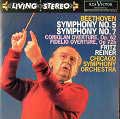 Others, though, will miss the interpretive currents stirred and depths plumbed in the personal visions of most other legendary conductors. But Reiner's is not a literal reading of the score - the plaintive oboe solo in the development of the first movement is deeply hushed and the molto retards in the scherzo are stretched into pauses. Reiner's clarity lets the subtly shifting moods emerge naturally in the Seventh, which is spectacularly well-played and -recorded. The Coriolan Overture is swift and insistent without seeming driven. His Fidelio brilliantly reflects the overture's schizoid nature, setting the opera's opening mood of domestic fluff while hinting of premonitions of the graver things about to unfold. Others, though, will miss the interpretive currents stirred and depths plumbed in the personal visions of most other legendary conductors. But Reiner's is not a literal reading of the score - the plaintive oboe solo in the development of the first movement is deeply hushed and the molto retards in the scherzo are stretched into pauses. Reiner's clarity lets the subtly shifting moods emerge naturally in the Seventh, which is spectacularly well-played and -recorded. The Coriolan Overture is swift and insistent without seeming driven. His Fidelio brilliantly reflects the overture's schizoid nature, setting the opera's opening mood of domestic fluff while hinting of premonitions of the graver things about to unfold.
- Beethoven: Piano Concerto # 5 (“Emperor”) (5/61). Rachmaninoff: Piano Concerto # 2 (3-4/62). Both with Van Cliburn. RCA 61961.
- For me, this is the only disappointment in this series. While the precise orchestral accompaniments are beautifully played and recorded, the pianism is glib and superficial, with barely a hint of genuine feeling.
 While the notes and accents all are in place, a crucial vitalizing spark is missing. Perhaps this approach can be viewed as respect for the inherent classicism of the Beethoven (of which Reiner produced a far more vital 1952 account with Horowitz and the RCA Symphony Orchestra, currently on Philips 456 841-2), but no such rationale can excuse the Rachmaninoff, which arrives stillborn and never revives. While the notes and accents all are in place, a crucial vitalizing spark is missing. Perhaps this approach can be viewed as respect for the inherent classicism of the Beethoven (of which Reiner produced a far more vital 1952 account with Horowitz and the RCA Symphony Orchestra, currently on Philips 456 841-2), but no such rationale can excuse the Rachmaninoff, which arrives stillborn and never revives.
- Briefly Noted - Several other Living Stereos in which Reiner and the Chicago Symphony are accompanists have been released on CDs packaged around the soloist: the Schumann Concerto with Cliburn (packaged with the Prokofiev Concerto # 3 with Hendl and the Chicago) on RCA 62691; the Rachmaninoff Concerto # 1 with Janis (packaged with the Rachmaninoff Concerto # 3 with Munch/Boston) on RCA 68762; and the Rachmaninoff Rhapsody on a Theme of Paganini (packaged with the Falla Nights in the Gardens of Spain with Jorda/San Francisco and the Chopin Andante Spinato and Grand Polonaise with Wallenstein/Symphony of the Air) on RCA 68886. Each is a fine performance but the fillers are less impressive and discourage purchase by Reiner fans.
- Brahms: Violin Concerto (2/55); Tchaikovsky: Violin Concerto (4/57). Both with Jascha Heifetz. RCA 61495.
- In the original LP album notes to LSC-2129, Charles O'Connell proclaimed the Tchaikovsky an example of syzygy - when two stars pass while maintaining their separate identities.
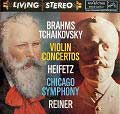 I'm not sure that's true here - although Heifetz often recorded with compliant lesser-known conductors to accommodate his commanding temperament, there was no need to resolve a battle of artistic egos or to compromise differing outlooks with Reiner, who among great conductors came closest to sharing the Heifetz approach. Here were two of a kind - supreme virtuosos in pursuit of a common goal and for whom emotion arose subtly and naturally from technical perfection, precision and clarity. Sadly, these are the only two recordings Heifetz and Reiner made together, but they're justly famous. In the spirit of the 19th century, Heifetz plays his own fiendishly difficult cadenza in the Brahms. I'm not sure that's true here - although Heifetz often recorded with compliant lesser-known conductors to accommodate his commanding temperament, there was no need to resolve a battle of artistic egos or to compromise differing outlooks with Reiner, who among great conductors came closest to sharing the Heifetz approach. Here were two of a kind - supreme virtuosos in pursuit of a common goal and for whom emotion arose subtly and naturally from technical perfection, precision and clarity. Sadly, these are the only two recordings Heifetz and Reiner made together, but they're justly famous. In the spirit of the 19th century, Heifetz plays his own fiendishly difficult cadenza in the Brahms.
- Dvorak: Symphony # 9 (“From the New World”) (11/57), Carnival Overture (1/56); Smetana: The Bartered Bride: Overture (12/55); Weinberger: Schwanda: Polka and Fugue (1/56). RCA 62587.
- Reiner's respectful, but by no means dull, reading helps to restore some of the inherent gleam to an old master by stripping away layers of interpretive varnish and presenting the original colors with balance and clarity.
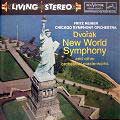 The haunting largo is especially effective in this treatment, striking a fine balance between the torpor of Klemperer's misdirected literalism and the edgy dynamic excitement of Kabasta's involvement. The Carnival Overture works up a full head of steam by the end and the Smetana's persistent energetic drive lacks only the emphatic rustic snarl of his compatriot George Szell's reading. The haunting largo is especially effective in this treatment, striking a fine balance between the torpor of Klemperer's misdirected literalism and the edgy dynamic excitement of Kabasta's involvement. The Carnival Overture works up a full head of steam by the end and the Smetana's persistent energetic drive lacks only the emphatic rustic snarl of his compatriot George Szell's reading.
- Rimsky-Korsakoff: Scheherazade, with Sidney Harth, violin (2/60). Stravinsky: Song of the Nightingale (11/56). RCA 68168.
- With its supple melodies, fetching solo turns, intoxicating interplay of instrumental colors and surging structure, Scheherazade bursts with sure-fire appeal; it's hard to even imagine an ineffective performance.
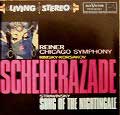 Even without Stokowski's outright sensuality, Bernstein's combustive energy, Fried's startling impulsiveness or Beecham's showcase of improvisation, Reiner's relatively straight-forward approach still delivers the music to full effect (although even he can't resist an extra surge of excitement in the final movement). The Stravinsky is an extreme contrast - sharp, harsh, ascetic and brittle, far more concerned with detailing the balletic narrative than with setting a comforting mood. Reiner's pointillistic performance highlights the astringent character of this score. It's appropriate, but a rude shock after having been nestled in the veils of Scheherazade. Even without Stokowski's outright sensuality, Bernstein's combustive energy, Fried's startling impulsiveness or Beecham's showcase of improvisation, Reiner's relatively straight-forward approach still delivers the music to full effect (although even he can't resist an extra surge of excitement in the final movement). The Stravinsky is an extreme contrast - sharp, harsh, ascetic and brittle, far more concerned with detailing the balletic narrative than with setting a comforting mood. Reiner's pointillistic performance highlights the astringent character of this score. It's appropriate, but a rude shock after having been nestled in the veils of Scheherazade.
- Mussorgsky: Pictures at an Exhibition (orchestrated by Ravel) (12/1957), A Night on Bald Mountain; Tchaikovsky: Marche miniature, Marche Slav; Borodin: Prince Igor: Polovtsian March; Kabalevsky: Colas Breugnon: Overture; Glinka: Russlan and Ludmilla: Overture (all 3/59). RCA 61958.
- Reiner's promenade through the Pictures is a rather slow stroll (33 minutes) yet hugely affecting, as he takes the time to burrow into the deeper meaning of each portrait,
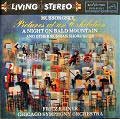 and at the same time affords an opportunity to appreciate the splendor of Ravel's magnificent orchestration. Thus, the old castle is indeed haunting, the oxcart lumbers with the weight of a peasant's burden of life, the “Goldberg and Schmuyle” episode evolves into a sad social commentary of indifference toward the have-nots, the marketplace bustles with the multiple layers of activity and human interaction, Baba Yaga is chillingly grotesque. Although at first disappointing, the Great Gate finale is greatly understated, but perhaps deliberately so, to avoid overpowering splendor detracting from the significance of the human drama already depicted. Of the fillers, the Night on Bald Mountain, while never quite demonic, still manages a startling mix of control and energy that, in a subtle way, creates a fine effect by suggesting, rather than depicting outright, the stylized terror. A persistent monochromatic mood, though, unduly stifles the Marche Slav until the final pages. and at the same time affords an opportunity to appreciate the splendor of Ravel's magnificent orchestration. Thus, the old castle is indeed haunting, the oxcart lumbers with the weight of a peasant's burden of life, the “Goldberg and Schmuyle” episode evolves into a sad social commentary of indifference toward the have-nots, the marketplace bustles with the multiple layers of activity and human interaction, Baba Yaga is chillingly grotesque. Although at first disappointing, the Great Gate finale is greatly understated, but perhaps deliberately so, to avoid overpowering splendor detracting from the significance of the human drama already depicted. Of the fillers, the Night on Bald Mountain, while never quite demonic, still manages a startling mix of control and energy that, in a subtle way, creates a fine effect by suggesting, rather than depicting outright, the stylized terror. A persistent monochromatic mood, though, unduly stifles the Marche Slav until the final pages.
- Tchaikovsky: Piano Concerto # 1, with Emil Gilels, piano (11/55); The Nutcracker, Excerpts (3/59). RCA 68530.
- Unless you truly hate this admittedly overexposed music, you'll be pleasantly surprised. In the Concerto, Reiner's precise discipline provides a perfect foil for Gilels' fiery poetry;
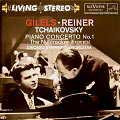 they form a beautifully integrated team, responsive and ardent without lapsing into pathos. The finale is spectacular - breathtakingly paced yet still under firm control. The Nutcracker consists of the standard suite expanded by the opening Christmas tree scene, two more divertissement dances, the pas de deux sequence and the final waltz and apotheosis.. Without slighting the inherent charm and brilliance of the score, Reiner treats it with respect. It's a brilliant demonstration that beyond a strikingly novel approach (which may make a strong initial impression but wears thin quickly [and thus defeats the purpose of a “permanent” recording]) a prime way to foster renewed appreciation for a well-worn score is to play it with care and attention to detail. Reiner's moderate pacing is invigorated with strong rhythmic vitality and the result is idiomatic and highly satisfying. The recording, though, is a bit sub-par, harsh and lacking the depth and detail of the other Living Stereos. they form a beautifully integrated team, responsive and ardent without lapsing into pathos. The finale is spectacular - breathtakingly paced yet still under firm control. The Nutcracker consists of the standard suite expanded by the opening Christmas tree scene, two more divertissement dances, the pas de deux sequence and the final waltz and apotheosis.. Without slighting the inherent charm and brilliance of the score, Reiner treats it with respect. It's a brilliant demonstration that beyond a strikingly novel approach (which may make a strong initial impression but wears thin quickly [and thus defeats the purpose of a “permanent” recording]) a prime way to foster renewed appreciation for a well-worn score is to play it with care and attention to detail. Reiner's moderate pacing is invigorated with strong rhythmic vitality and the result is idiomatic and highly satisfying. The recording, though, is a bit sub-par, harsh and lacking the depth and detail of the other Living Stereos.
- Tchaikovsky: Symphony # 6 (“Pathetique”) (4/57), 1812 Overture (1/56); Liszt: Mephisto Waltz (12/55). RCA 61246.
- The 1812 Overture stands as perhaps the ultimate example of Reiner's redemption of a tired and often tiresome old warhorse. Most modern performances rely on sonic gimmickry for their impact.
 Reiner, though, foregoes the usual cannons, fireworks and carillons. Instead, he simply plays the music with unembellished enthusiasm. As a result, a piece of flashy junk emerges as a fine piece of musical craftsmanship. In revealing its intrinsic value, Reiner's reading is not only powerful in its own right, but makes the standard aural sideshow seem utterly ridiculous by comparison. In the Pathetique, though, the rhetoric of the past can't be so readily dismissed as gratuitous. Furtwangler, Mengelberg, Koussevitsky, Mravinsky and others' deeply personal interpretive overlays form a rich and valuable tradition, against which Reiner's comparative objectivity isn't quite as refreshing. Reiner, though, foregoes the usual cannons, fireworks and carillons. Instead, he simply plays the music with unembellished enthusiasm. As a result, a piece of flashy junk emerges as a fine piece of musical craftsmanship. In revealing its intrinsic value, Reiner's reading is not only powerful in its own right, but makes the standard aural sideshow seem utterly ridiculous by comparison. In the Pathetique, though, the rhetoric of the past can't be so readily dismissed as gratuitous. Furtwangler, Mengelberg, Koussevitsky, Mravinsky and others' deeply personal interpretive overlays form a rich and valuable tradition, against which Reiner's comparative objectivity isn't quite as refreshing.
- “Spain” - de Falla: El amor brujo, with Leontyne Price, soprano (3/63); The Three-Cornered Hat: Dances; La vida breve: Interlude and Dances; Albinez: Iberia: Triana and Fete-dieu a Seville, Navarra; Granados: Goyescas: Intermezzo (all 4/58). RCA 62586.
- May I digress a moment? The only sour notes in this reissue project are the asinine blurbs splashed across the backs of each jewelbox that seem designed to insult the intelligence of any knowledgeable buyer.
 Typical is the come-on from this one: “Vocal legend Leontyne Price joins the Golden Age's greatest conductor and orchestra for performances that burn from the heart. Spain is the definitive cornerstone of every musical collection.” Price was indeed a legend, but the rest is sheer bunk. Reiner wasn't even part of the so-called “Golden Age,” much less its greatest conductor; rather, he was a modernist and had no meaningful roots in the previous century. The Chicago was (and remains) a great orchestra, but surely no greater than those of Vienna, Berlin or Philadelphia. Reiner didn't burn from the heart or anywhere else; his strength was that he was cold as ice. And to exaggerate the importance of a bunch of pleasant Spanish ballet excerpts is simply absurd. But don't let the literary hyperbole scare you off. El amor brujo is a magnificent, haunting performance. It may never burst into flame, but instead it smolders with repressed yearning. Reiner's measured, evocative subtlety is abetted by Price's unaffected, plaintive singing (a difficult feat for a diva). The fillers, too, benefit from the care lavished by Reiner and the precision of the Chicago musicians. Typical is the come-on from this one: “Vocal legend Leontyne Price joins the Golden Age's greatest conductor and orchestra for performances that burn from the heart. Spain is the definitive cornerstone of every musical collection.” Price was indeed a legend, but the rest is sheer bunk. Reiner wasn't even part of the so-called “Golden Age,” much less its greatest conductor; rather, he was a modernist and had no meaningful roots in the previous century. The Chicago was (and remains) a great orchestra, but surely no greater than those of Vienna, Berlin or Philadelphia. Reiner didn't burn from the heart or anywhere else; his strength was that he was cold as ice. And to exaggerate the importance of a bunch of pleasant Spanish ballet excerpts is simply absurd. But don't let the literary hyperbole scare you off. El amor brujo is a magnificent, haunting performance. It may never burst into flame, but instead it smolders with repressed yearning. Reiner's measured, evocative subtlety is abetted by Price's unaffected, plaintive singing (a difficult feat for a diva). The fillers, too, benefit from the care lavished by Reiner and the precision of the Chicago musicians.
- “Vienna” - Johann Strauss, Jr.: Morning Papers, Emperor Waltz, On the Beautiful Blue Danube (all 4/57), Vienna Blood, Roses from the South, Treasure Waltz, Thunder and Lightning (all 4/60); Weber: Invitation to the Dance (4/57); Josef Strauss: Village Swallows (4/57); Richard Strauss: Der Rosenkavalier: Waltzes (4/57). RCA 68160.
- For a disc of Strauss favorites, this collection is a winner, played with great sensitivity, taste and care. While generally restrained, there's still genuine Viennese inflection and character
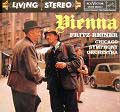 (including, alas, cloying birdie sounds in Village Swallows) and even a few surprises (a hurdy-gurdy effect in Roses From the South). Crisp playing really ignites Thunder and Lightning. Although Reiner acquits himself well with the lesser stuff, there's a tangible extra jolt of attention and energy for the Rosenkavalier Waltzes, as if to make clear where among the various Strausses his sympathies really lay. Speaking of which … (including, alas, cloying birdie sounds in Village Swallows) and even a few surprises (a hurdy-gurdy effect in Roses From the South). Crisp playing really ignites Thunder and Lightning. Although Reiner acquits himself well with the lesser stuff, there's a tangible extra jolt of attention and energy for the Rosenkavalier Waltzes, as if to make clear where among the various Strausses his sympathies really lay. Speaking of which …
- Strauss: Also Sprach Zarathustra (3/54), Ein Heldenleben, with John Weicher, violin (3/54). RCA 61494.
- Strauss: Elektra: Elektra's Soliliquy, Recognition Scene and Finale, with Inge Borkh as Elektra, Paul Schoeffler as Orest and Frances Yeend as Chrysothemis (4/56); Salome: Dance of the Seven Veils (3/54) and Final Scene, with Inge Borkh as Salome (12/55). RCA 68636.
- Strauss: Don Quixote, with Antonio Janigro, cello; Don Juan (1954). RCA 68170.
- Strauss: Also Sprach Zarathustra (1962); Burleske, with Byron Janis, piano (1957); Der Rosenklavier: Waltzes (1957). RCA 68638.
- Strauss: Sinfonia Domestica; Bourgeois Gentilhomme Suite (both 1956). RCA 68637.
- Reiner's special affection for and devotion to Richard Strauss, as his colleague, friend and advocate, is reflected in his recordings, which are more numerous than of any other composer, and include his only RCA remakes.
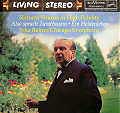 Unfortunately, I don't fully share his enthusiasm, so my comments are undoubtedly shorter and less perceptive than they should be. All the readings emphasize abstract music in lieu of weighty philosophical underpinning and diffuse programmatic considerations. Ironically, unlike the deep inflections of many other conductors, especially those who shared the composer's German roots, the closest parallel on record are Strauss's own 78s in which he just plays the music efficiently and leaves the interpretation to others. For Strauss fans, all of the performances are safe bets, with wonderful execution and sound. The first two listed discs, though, are of special interest. Upon initial release, Zarathustra and Heldenleben were touted for their sonic excellence and indeed it's hard to believe that such extraordinary full stereo recordings were made in March 1954. (Beyond a February 1954 taping with Munch in Boston, these were RCA's very first venture into stereo. It was indeed a pioneering risk - although stereo tapes were offered the next year, it would be four years before disc technology brought stereo LPs into homes.) The disc of opera excerpts wanders intriguingly off the beaten path. The Salome finale, in particular, while not as overtly dramatic as the celebrated Solti/Nilsson recording nor as sensual as Leinsdorf/Caballe, is positively chilling in the perversity of its stylized horror. Unfortunately, I don't fully share his enthusiasm, so my comments are undoubtedly shorter and less perceptive than they should be. All the readings emphasize abstract music in lieu of weighty philosophical underpinning and diffuse programmatic considerations. Ironically, unlike the deep inflections of many other conductors, especially those who shared the composer's German roots, the closest parallel on record are Strauss's own 78s in which he just plays the music efficiently and leaves the interpretation to others. For Strauss fans, all of the performances are safe bets, with wonderful execution and sound. The first two listed discs, though, are of special interest. Upon initial release, Zarathustra and Heldenleben were touted for their sonic excellence and indeed it's hard to believe that such extraordinary full stereo recordings were made in March 1954. (Beyond a February 1954 taping with Munch in Boston, these were RCA's very first venture into stereo. It was indeed a pioneering risk - although stereo tapes were offered the next year, it would be four years before disc technology brought stereo LPs into homes.) The disc of opera excerpts wanders intriguingly off the beaten path. The Salome finale, in particular, while not as overtly dramatic as the celebrated Solti/Nilsson recording nor as sensual as Leinsdorf/Caballe, is positively chilling in the perversity of its stylized horror.
- Wagner: Die Meistersinger: Prelude to Act I, Prelude to Act III, Dance of the Apprentices, Procession of the Meistersingers; Gotterdammerung: Siegfried's Rhine Journey, Siegfried's Funeral Music (all 4/59); Strauss: Don Juan (2/60). RCA 63301.
- These are exquisite, full-bodied readings that focus attention on the splendor of Wagner's orchestration.
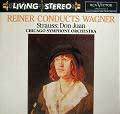 While avoiding the overt sensuality of Stokowski, Reiner conjures breathtakingly gorgeous, ardent playing from his orchestra, complemented by superb sound (and a much riper bass than usual). Tempos are patient and effectively paint the mood of each section, perhaps to compensate for the lack of explanatory narrative context or theatrical action. Thus, Reiner makes us feel the soft evolution of the dawn and the dry funeral grief of the Gotterdammerung excerpts. The Don Juan is fine, but so are many other versions. While avoiding the overt sensuality of Stokowski, Reiner conjures breathtakingly gorgeous, ardent playing from his orchestra, complemented by superb sound (and a much riper bass than usual). Tempos are patient and effectively paint the mood of each section, perhaps to compensate for the lack of explanatory narrative context or theatrical action. Thus, Reiner makes us feel the soft evolution of the dawn and the dry funeral grief of the Gotterdammerung excerpts. The Don Juan is fine, but so are many other versions.
- Respighi: Fountains of Rome, Pines of Rome (10/59); Debussy: La mer (2/60). RCA 68079.
- Reminiscent of Toscanini's celebrated readings, Reiner works wonders by playing these garish scores straight and something remarkable emerges - they actually sound like good, well-constructed, and occasionally inspired music.
 There indeed is virtue in simplicity. And, as with Toscanini's in their day, the sound is stunning, especially in detailing the dense writing of the climaxes (although in Toscanini's hands they become more exciting). The Debussy, too, was a Toscanini triumph which Reiner emulates by clarifying the complex interplay of instrumental lines and colors; the result, though, is a bit studied and reticent when compared to Toscanini's surging, driven vitality. There indeed is virtue in simplicity. And, as with Toscanini's in their day, the sound is stunning, especially in detailing the dense writing of the climaxes (although in Toscanini's hands they become more exciting). The Debussy, too, was a Toscanini triumph which Reiner emulates by clarifying the complex interplay of instrumental lines and colors; the result, though, is a bit studied and reticent when compared to Toscanini's surging, driven vitality.
- Mahler: Symphony # 4, with Lisa Della Casa, soprano (12/58). RCA 63533.
- In his only album note, Reiner conceded that he was a belated convert to Mahler. One of the few conductors of his generation who never experienced Mahler directly, Reiner brings a fresh perspective
 to this evergreen work and the result is one of his finest, if least heralded, recordings. Huge tempo swings combine with heightened prominence of woodwinds and highlighted inner voices to lend an unusual but highly appropriate rustic quality unique among other versions. The spotlighting of instrumental textures and sharp brass accents, abetted by crystalline recording, all suggest the sense of discovery that Reiner undoubtedly felt and his consequent willingness to cast aside traditional Mahler interpretative approaches. As only a single example, the opening sleigh-bell motif begins the work at an edgy, uncomfortable pace and leaps ahead at each reappearance. The performance is capped by a ravishing lyrical finale that belies the naiveté of the text but is affecting nonetheless in its simplicity and liquid charm. to this evergreen work and the result is one of his finest, if least heralded, recordings. Huge tempo swings combine with heightened prominence of woodwinds and highlighted inner voices to lend an unusual but highly appropriate rustic quality unique among other versions. The spotlighting of instrumental textures and sharp brass accents, abetted by crystalline recording, all suggest the sense of discovery that Reiner undoubtedly felt and his consequent willingness to cast aside traditional Mahler interpretative approaches. As only a single example, the opening sleigh-bell motif begins the work at an edgy, uncomfortable pace and leaps ahead at each reappearance. The performance is capped by a ravishing lyrical finale that belies the naiveté of the text but is affecting nonetheless in its simplicity and liquid charm.
- Prokofiev: Lieutenant Kije Suite (3/57); Hovhaness: Mysterious Mountain (Symphony # 2) (4/58); Stravinsky: The Fairy's Kiss: Divertimento (4/58). RCA 61957.
- One of the finest of all of Reiner records is his reading of the Lt. Kije Suite, Prokofiev's incidental music for a long-forgotten 1933 Russian film. The title character is
 created by a typographical error in a military report to the Czar, and so to avoid embarrassment (or worse) Kije's inventors detail the life of their “hero” from birth to burial. In keeping with Kije's fictitious origins, Prokofiev paints his musical biography in purely mock emotions, using, for example, bland fanfares to announce his birth and a whiny cello and plaintive bassoon to drain the love theme of any ardor. All of this wryness is captured perfectly by Reiner's dry precision, which conveys subtle sarcasm through an exquisite blend of accents, balances and phrasing. The other works both hark back to earlier times and styles. The Stravinsky is intended in the idiom of Tchaikovsky but with distinct neoclassic overtones, resulting in a lean, coy attitude which Reiner expresses wonderfully. The Hovhaness, although written in 1955, is deeply romantic. Despite its mystical title and ambitious program it's very easy on the ears and Reiner makes the most of its colorful content. The composer, incidentally, is astoundingly prolific - this was the second of over 50 symphonies! created by a typographical error in a military report to the Czar, and so to avoid embarrassment (or worse) Kije's inventors detail the life of their “hero” from birth to burial. In keeping with Kije's fictitious origins, Prokofiev paints his musical biography in purely mock emotions, using, for example, bland fanfares to announce his birth and a whiny cello and plaintive bassoon to drain the love theme of any ardor. All of this wryness is captured perfectly by Reiner's dry precision, which conveys subtle sarcasm through an exquisite blend of accents, balances and phrasing. The other works both hark back to earlier times and styles. The Stravinsky is intended in the idiom of Tchaikovsky but with distinct neoclassic overtones, resulting in a lean, coy attitude which Reiner expresses wonderfully. The Hovhaness, although written in 1955, is deeply romantic. Despite its mystical title and ambitious program it's very easy on the ears and Reiner makes the most of its colorful content. The composer, incidentally, is astoundingly prolific - this was the second of over 50 symphonies!
- Prokofiev: Alexander Nevsky (3/59), with Rosalind Elias (mezzo-soprano) and the Chicago Symphony Chorus. {Paired with Khachaturian: Violin Concerto, with Leonid Kogan, violin and the Boston Symphony Orchestra conducted by Pierre Monteux (1/58)}. RCA 63708.
- It's a shame that Reiner recorded so little Prokofiev, for whose wry expression he would have been an ideal conduit. We can only infer the splendor of a Reiner-led Fifth Symphony, Third Piano Concerto
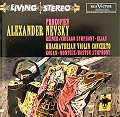 or Romeo and Juliet, since beyond Lt. Kije all we have is this second film score, Alexander Nevsky. In his memoirs, director Sergei Eisenstein saluted his collaboration with Prokofiev, who was able to reflect the accents, rhythms and nuances of the montage and to grasp and convey the inner meaning of a scene. Reiner's precise and powerful performance of the deeply affecting cantata derived from the movie score is a superb realization of its epic grandeur and operatic stylization, all seasoned with jingoistic fervor and abetted by a stunning recording. It would have been nice to have completed the disc with another of Reiner's Living Stereo LP cuts, but it's hard to complain when the filler instead is one of the most serious omissions from RCA's 1994 Pierre Monteux Edition - a magnificent reading of the flashy Khachaturian Violin Concerto in which the veteran conductor and the Boston Symphony provide an attentive foil for the electrifying solo turns of Leonid Kogan in his American debut. or Romeo and Juliet, since beyond Lt. Kije all we have is this second film score, Alexander Nevsky. In his memoirs, director Sergei Eisenstein saluted his collaboration with Prokofiev, who was able to reflect the accents, rhythms and nuances of the montage and to grasp and convey the inner meaning of a scene. Reiner's precise and powerful performance of the deeply affecting cantata derived from the movie score is a superb realization of its epic grandeur and operatic stylization, all seasoned with jingoistic fervor and abetted by a stunning recording. It would have been nice to have completed the disc with another of Reiner's Living Stereo LP cuts, but it's hard to complain when the filler instead is one of the most serious omissions from RCA's 1994 Pierre Monteux Edition - a magnificent reading of the flashy Khachaturian Violin Concerto in which the veteran conductor and the Boston Symphony provide an attentive foil for the electrifying solo turns of Leonid Kogan in his American debut.
- Bartok: Concerto For Orchestra (10/55), Music for Strings, Percussion and Celeste (12/58), Hungarian Sketches (12/58). RCA 61504.
- Reiner's recording of the 1943 Concerto For Orchestra is important, as it documents the understanding between the ailing composer and his long-time friend and champion whose efforts led to its creation.
 The result is doubly suited to Reiner's artistic strengths. First, as each instrument is given its moment to shine but without ostentation, it's a showcase for a well-balanced and well-integrated virtuoso ensemble and thus fully matches the approach of the conductor and his orchestra. Second and more important is that Reiner captures its emotional essence as the self-portrait of a deeply conflicted artist. Bartok was free in America, but his native land was in agony. His work is touched with the spirit of the Hungarian folk music he loved so much, yet tinged with sadness over his exile from the country he probably knew he would never see again. Its emotions are repressed, its flights of freedom quickly pulled to earth. Reiner's definitive reading captures all of this. He also captures and clearly delineates the disparate moods of each movement of the Music for Strings, Percussion and Celeste, especially the other-worldly spookiness of the adagio (used to great effect in Kubrick's “The Shining”). Sadly, although Reiner led the world premiere of the Piano Concerto # 1 and gave introduced many of the composer's other works to America, this is all the Bartok Reiner ever recorded. The result is doubly suited to Reiner's artistic strengths. First, as each instrument is given its moment to shine but without ostentation, it's a showcase for a well-balanced and well-integrated virtuoso ensemble and thus fully matches the approach of the conductor and his orchestra. Second and more important is that Reiner captures its emotional essence as the self-portrait of a deeply conflicted artist. Bartok was free in America, but his native land was in agony. His work is touched with the spirit of the Hungarian folk music he loved so much, yet tinged with sadness over his exile from the country he probably knew he would never see again. Its emotions are repressed, its flights of freedom quickly pulled to earth. Reiner's definitive reading captures all of this. He also captures and clearly delineates the disparate moods of each movement of the Music for Strings, Percussion and Celeste, especially the other-worldly spookiness of the adagio (used to great effect in Kubrick's “The Shining”). Sadly, although Reiner led the world premiere of the Piano Concerto # 1 and gave introduced many of the composer's other works to America, this is all the Bartok Reiner ever recorded.
- Back to mono - Before stereo (living or otherwise) there was mono, and before the Chicago Symphony there was Pittsburgh, where Reiner flourished from 1938 to 1948. Although Reiner's Chicago records are his most highly acclaimed (and deservedly so), Pittsburgh became a wonderful ensemble under Reiner's taut leadership. The French Lys label has released ten discs of their work. Despite indifferent transfers, there are some incredible performances and some real surprises, including a seemingly uncharacteristic but wholly credible Gershwin Porgy and Bess Symphonic Portrait. Far more impressive sonically are two restorations from original masters in the Sony Masterworks Heritage series. MHK 62343 features the Shostakovich Symphony # 6 and short pieces by Kodaly and Weiner. MHK 62344 has the Mozart Symphonies 35 and 40 and the Beethoven Second which must have been startling in their day when compared to the romanticized norm of the time, but now their lean, direct clarity has become our accustomed standard.
- MIA - I've focused on the RCA/BMG Living Stereo series, only because the sound is generally superb and hopefully all of the Reiner/Chicago LPs will eventually appear. Yet to surface (although some are available on other CDs) are Beethoven's Symphonies 1, 6 and 9; Berlioz's Nuits d'Ete (with Leontyne Price); Brahms's Symphony # 3 and Piano Concerto # 2 (with Emil Gilels); Mahler's Das Lied von der Erde (with Forrester and Lewis); Rossini Overtures; and Verdi's Requiem Mass. As these are added to the Living Stereo series, I'll update the principal listing to include them.
But keep your fingers crossed - as I'm finishing this survey (April 2000), BMG just announced a drastic reduction of its classical division. While the immediate impact is to be the cancellation of long-term artist contracts and the constriction of new projects, the news also blows a chill wind over the prospect for further reissues, including, perhaps, completion of the Living Stereo project. And since past cost-cutting among the major labels has often meant consolidation of inventory, some of the great items listed above may not survive whatever cuts lie ahead, so you'd better grab them while you still can!

Copyright 2000 by Peter Gutmann
|